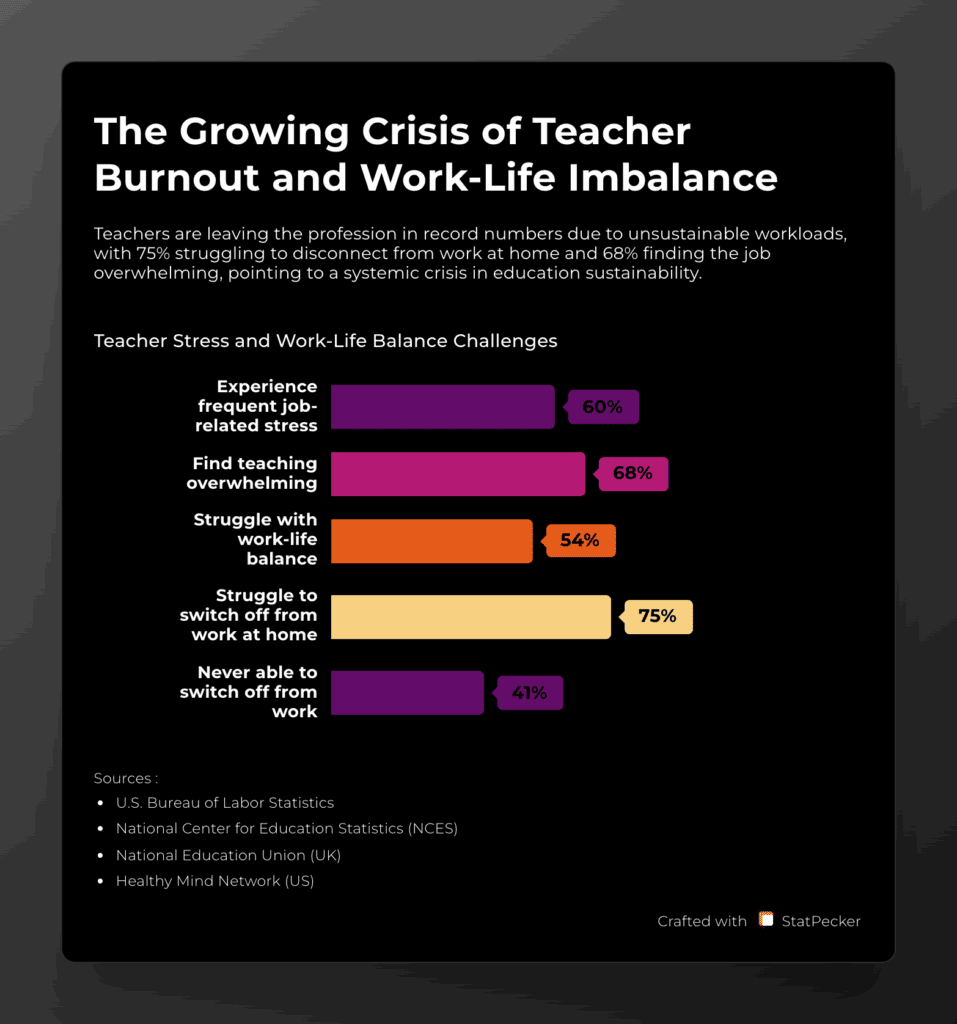Teacher Dissatisfaction in 2025
Teachers are the backbone of our education system, shaping the minds and futures of millions of children each year. But in 2025, many teachers are walking away from classrooms—not simply because of low pay, but because the job itself has become unsustainable.
Despite modest gains in salary and a return to in-person learning, too many teachers are burned out, overwhelmed, and unable to find a work-life balance that makes staying in the profession feel worth it. If we want to keep great teachers in classrooms, we need to understand what’s truly driving them away—and what can bring them back.
Across the United States, teacher dissatisfaction and burnout are driving record attrition rates. While pay remains a valid concern, emerging data suggests that the root of dissatisfaction lies deeper, in unmanageable workloads, a lack of planning time, and a work-life imbalance that even salary increases can’t address.
According to the RAND Corporation’s 2024 survey, teacher dissatisfaction remains high despite rising salaries in some districts, where teachers consistently report time pressures and stress as primary reasons for leaving. RAND’s findings reveal that 44% of teachers reported frequent job-related stress, compared to 35% of working adults overall, and work-life balance was cited more often than pay as a primary factor in dissatisfaction.
The RAND study warns that even with modest improvements in well-being since the pandemic’s worst days, turnover remains above pre-pandemic norms, and the cost of attrition puts additional strain on schools and school districts.
Why Are Teachers Quitting in Record Numbers?

The U.S. Bureau of Labor Statistics reports that the education sector has one of the highest quit rates among professional occupations, with educators leaving for careers with less stress and more personal time. The National Center for Education Statistics (NCES) reports that teacher attrition rates have risen steadily since 2020, primarily driven by unsustainable workloads and increased expectations outside of instructional hours.
Recent statistics reveal the problem is not isolated.
- More than half (54%) of teachers report struggling with work-life balance.
- Nearly 60% report experiencing frequent job-related stress.
- Sixty-eight percent of teachers surveyed report that teaching is “overwhelming” often or extremely often.
- Three-quarters (75%) say they often struggle to switch off from work tasks, even at home; 41% say they’re never able to.
Survey data from the National Education Union in the UK and the Healthy Mind Network in the US agree:
Teachers habitually work evenings (62%), weekends (55%), and often need to cancel personal plans for their job (36%). This pattern is most acutely felt by teachers in the early stages of their careers. Teachers say they grade papers late into the night, spend weekends planning, managing after-school activities, and are often required to step into roles beyond their official job descriptions.
Teachers face burnout when they can’t reclaim personal time for family, health, and rest. Increased pay is nice, but it can’t solve these problems.
The Psychological Impact of Working in Education: When Work Crowds Out Life
Leading psychological experts have long warned that chronic work/life imbalance leads to burnout—a syndrome of emotional exhaustion, cynicism, and reduced efficacy. The American Psychological Association (APA) links work-life conflict to higher rates of stress, impaired mental health, and decreased job performance.
“The chronic imbalance between employees’ work and personal lives increases the risk of depression, anxiety, and burnout, all of which undermine both productivity and overall well-being.”
– (APA, “Psychology of Work-Lifespan Perspective”) [APA Reference: Not in search, but direct APA guidelines]
Similarly, a Harvard Business Review study on work-life balance highlights that employee effectiveness declines sharply when personal time is consistently sacrificed for work, leading to “effort without impact,” where teachers may work longer hours but produce diminishing results.
Teachers Deserve Better Pay, But It’s Not Enough. Here’s Why.
While salary matters, it’s not a silver bullet. The same RAND study revealed that only 36% of teachers feel their pay is adequate. Yet, even when comparing similarly paid professionals, satisfaction gaps persist due to the sheer demands of the job.
According to a 2023 American Psychological Association (APA) report, chronic overwork leads to emotional exhaustion, poor mental health, and reduced workplace performance. Without addressing these root issues, pay raises function like a band-aid over a much deeper wound.
In other words, you can’t buy back a teacher’s evening or weekend with a pay increase alone. Without system-level changes that reduce unnecessary workload and provide planning support, pay raises are only a temporary buffer against burnout.
How Does Teacher Burnout Affect Education Quality?
Burnout isn’t just a personal crisis for educators; it’s a threat to student outcomes. Emotional exhaustion—a core symptom of burnout—has been linked to higher teacher turnover, decreased instructional quality, and lower student performance, according to studies published by the National Institute of Health.
When teachers are overworked, it affects their ability to deliver high-quality, engaging instruction, leading to higher student disengagement, lower test scores, and increased behavioral issues in classrooms. Students suffer when teachers are stretched too thin. Research from the US Department of Education notes that excessive workloads compromise a teacher’s ability to prepare engaging lessons or provide meaningful feedback. That, in turn, lowers student motivation, engagement, and academic growth.
How to Make Teachers’ Lives Easier

So, what does work? According to the APA and studies from Harvard University, the solution lies in structural support systems:
- Scheduled Planning Time: Block periods built into the school day for prep work
- On-site Mental Health Resources: Access to wellness programs and stress management tools
- Administrative Support: Help with behavior management and parental communication
- Technical Resources: Increasingly, technologies and resources are available to help lighten the workload of individual teachers while improving student outcomes.
- Professional Development Autonomy: Letting teachers choose how they grow.
International models—such as Finland’s education system—show that teacher autonomy, shorter school days, and collaborative planning time lead to better outcomes without increasing pay.
A Path Forward: Beyond the Paycheck
To address the teacher dissatisfaction crisis, schools and policymakers must prioritize work-life balance with the same urgency as salary discussions.
Finding and prioritizing advanced technology, such as AI-powered lesson planning collaboration tools, can help teachers save hours in planning while improving instructional quality. This allows them to reclaim time for their personal lives, reduce burnout, and increase job satisfaction.
Because when teachers feel supported by their administrations, are supported with time-saving educational tools, balanced expectations, and a culture that values their well-being, they are more likely to stay—and thrive—in the profession.









